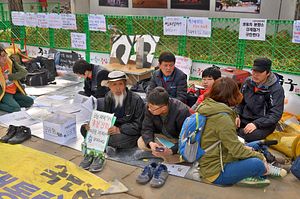Fifteen stories above the ground, Kim Jin-suk protested what she saw as the unfair dismissal of 400 workers at the Busan-based Hanjin Heavy Industries & Construction. The labor activist stayed atop the crane for 309 days between January and December 2011. According to reports, “She choose a crane where another trade unionist committed suicide several years ago during a separate labour row.” The spot, it goes without saying, has much symbolic value. And it was this symbolism that Kim Jin-suk sought to mobilize as leverage against the employer. The protest, which was popularized by mainstream media and Kim’s use of Twitter, succeeded in bringing public attention to the layoffs.
A similar protest has begun in Seoul, but this time atop a billboard. Last Wednesday (November 12), two former employees of Cable and More (C&M) scaled a billboard, which is “near the head of the office of MBK Partners, C&M’s major shareholder,” according to The Korea Times report on the protest, to “[demand] the reinstatement of 109 contract workers fired in July by the company and its affiliates.” C&M is “the biggest general broadcasting provider in the Seoul area,” according to the Hankyoreh. While the location of the public protest does not have the same symbolic value as the crane, the sight of two people standing atop a billboard in downtown Seoul is an attention-grabbing event and thus has a similar effect as Kim Jin-suk’s 309-day long stay on a crane.
This kind of labor protest is different from large union protests, the likes of which occurred in 1996 and 1997 following revisions to the National Labor Law, but it is not an uncommon form of expression by workers protesting what they see as unfair labor conditions. While we often attribute the power of labor to its ability to bring about a strike, there are other – symbolic – forms of protest. This is precisely what sociologist Jennifer Chun argues in her book Organizing at the Margins: The Symbolic Politics of Labor in South Korea and the United States. Channeling Pierre Bourdieu’s concept of the “power of recognition,” or, in his words (as quoted by Chun), “the power to consecrate or reveal things that are already there,” Chun shows how those at the “margins” of the labor force (viz., janitors, care workers, and golf assistants) in both the United States and South Korea were able to wage public dramas in a such a fashion as to generate symbolic leverage (or what Bourdieu might call “social capital”) that they could use to fight back against their own marginalization in an era of unmitigated global capital and the downward pressure it puts on workers and their efforts to act collectively.
The structural adjustments to the South Korean labor market implemented at the behest of the IMF during the 1997-1998 Asian Financial Crisis has made employment more volatile. Using numbers released by Statistics Korea, the Chosun Ilbo reports that an increasing number of people are working “non-regular jobs.” “The number of Koreans working on a contract basis rather than a full job stood at 6.08 million as of August, up 2.2 percent or 131,000 on-year.” Significantly, “one in three non-regular workers is a college graduate,” while “the number of those over 60 increased the most (11.1 percent).” Many of these non-regular jobs, Chosun notes, are in the service economy. This is a sector vulnerable to exploitation or just poor working conditions. Indeed, the cases covered by Chun in her book are in Korean and U.S. service industries.
While symbolic leverage generated by the act of staging a public drama can indeed generate attention and (if successful) pubic support, the end goal is to bring about some form of policy change or, at the very least, a concession by an employer.
Given the structural changes to South Korea’s economy and labor market over the last decade and a half, and the worldwide “race to the bottom,” one can reasonably expect more labor unrest and increased demands on governments to improve social protections. While Korea’s elderly are not likely to take to the streets or scale a billboard, those fit to do so likely will. Whether a sufficient amount of public support can be generated is an open question.
Despite South Korea’s failings with regard to welfare policy improvements, the government has shown signs it is willing to recognize the need for an enhanced social safety net. The ruling Saenuri Party and the opposition New Politics Alliance for Democracy came to an agreement last week on three “welfare revision bills.” According to The Korean Times, the bills “[aim] at expanding the scope of beneficiaries of the national basic livelihood social security system.” Sadly, the impetus for the reforms is attributed to a triple suicide that took place earlier this year when a mother and her two daughters decided that dying was preferable to living in poverty. The reforms are being referred to in the Korean-language media as the “three mother-daughter law.” This, too, could be seen as a form of symbolic leverage-generating protest, but one can only hope that those protesting poor living conditions would sooner climb to the top of a billboard or live in a crane than sacrifice their own lives.































